- 1School of Optics and Photonics, Beijing Engineering Research Center for Mixed Reality and Advanced Display, Beijing Institute of Technology, Beijing, China
- 2Department of Physics, Beijing Key Lab for Metamaterials and Devices, Key Laboratory for Terahertz Optoelectronics, Ministry of Education, Beijing Advanced Innovation Center for Imaging Theory and Technology, Capital Normal University, Beijing, China
Active control of terahertz (THz) wave polarization state is of great significance for sensitive detection, imaging and communication. Here, a tunable THz quarter wave plate is designed by electronically controlling a composite metasurface consisting of the gold cross antennas and a monolayer graphene. The graphene composite metasurface acts as a quarter-wave plate when the chemical potential of graphene is 0 eV, by which the polarization state of the incident THz wave is converted from linear polarization to circular polarization. After the chemical potential of graphene is increased gradually, and to 0.5 eV, the transmitted polarization state of the THz wave is changed from right circular polarization to right elliptical polarization, and to linear polarization. Furthermore, the polarization state of the THz wave is able to be changed from left circular polarization to left elliptical polarization, and to linear polarization if the device is clockwise rotated by 90°. Therefore, the polarization state of THz wave could be actively controlled by the proposed tunable THz quarter wave plate. Our work will offer a new avenue for tunable THz polarization modulation devices.
Introduction
Recently, tunable metasurfaces have attracted enormous research interests as a means to control the polarization state of THz wave. In the conventional optical devices, polarization control of electromagnetic wave is mainly achieved using birefringent materials. However, these materials are not suitable in the THz band because of the inherent disadvantages including bulky size, and narrow band of operating frequency. The most important issue is that the THz wave interacts weakly with these materials in nature.
Metasurface is a sub-wavelength artificial structure with extraordinary properties that nature materials do not have [1]. The electromagnetic wave properties including amplitude, phase, frequency and polarization can be controlled completely based on the structure of a metasurface, because any permittivity and permeability can be achieved after the modulation of metasurface devices. Therefore, more and more people have been committed to design metasurface structures, and proposed various functional devices including the anomalous reflection or refraction devices [2, 3], the holographic devices [4–6], the metasurface lenses [7–9], and the polarization-control devices [10–17], which mainly include the half-wave plate [10, 11], the quarter-wave plate [12–16], and the retarders [17]. These devices have the advantages of ultrathin thickness, high degree of design freedom and compactness, which will promote the miniaturization of the system. For example, Wang et al. designed an ultrathin THz quarter-wave plate using Babinet-inverted metasurface [14]. However, all the devices mentioned above are static, which hinders their convenience in the realistic application. Activating the functionalities of these devices will no doubt expand the application and improve the functional value, which is necessary to integrate tunable materials including the semiconductor [18, 19], the phase change material [20, 21], and graphene [22, 23], and externally control the functionalities by light [24], temperature [25], and an applied gate voltage [26]. More recently, a few THz polarization devices have been proposed [27–29]. Zhao et al. proposed a tunable transmission THz waveplate based on the electrically driving metasurface [28]. Luo et al. designed a dynamically reversible and strong circular dichroism based on Babinet-invertible chiral metasurface [29]. However, polarization devices whose function is tunable in the THz band is still vary lacking.
In this paper, we design a tunable THz quarte-wave plate (TQWP) by integrating a monolayer graphene with a metasurface consisting of the anisotropic gold cross arrays for actively and completely controlling the THz polarization state. The resonance characteristics of the cross will be modulated when the Fermi energy of the graphene is changed by an external voltage [30, 31]. A polarization state conversion from right circular polarization undergoes right elliptical polarization, and to linear polarization of 45° is achieved by changing the chemical potential of graphene from 0 to 0.5 eV, in which the device is irradiated normally by a linear polarized THz plane wave with a polarization angle of 45° to the x-axis. We further achieved the THz polarization conversion from left circular polarization state undergoes left elliptical polarization state, and to linear polarized of 135° only making the device clockwise rotate by 90°.
Design of Structure
The tunable TQWP is designed as shown in Figure 1A. The device is irradiated normally by a linear polarized THz plane wave. After modulated by this device, the THz polarization state is transformed to a circular state at first. Then, the polarization state of THz is changed from circular polarization goes through elliptical polarization and eventually returns to linear polarization with a changed gate voltage that increases the Fermi energy of the graphene. The tunable TQWP is consisting of three parts, including the monolayer graphene, the metasurface, and the silicon. The metasurface is composed of the anisotropic gold cross arrays, as shown in Figure 1B, and the unit cell of the metasurface is depicted in Figure 1C. The period of the unit cell is 100 μm. The arm lengths of the cross are
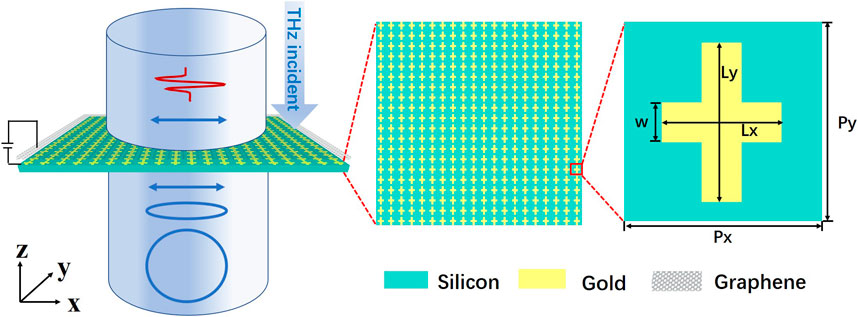
FIGURE 1. (A) Diagram of the working principle of the tunable TQWP; (B) Schematic of the metasurface consisting of the gold anisotropy cross arrays; (C) Schematic of one unit cell among the gold gross arrays.
Results and Discussion
Numerical simulations are then carried out to confirm the functions of the designed graphene composite metasurface. Graphene is a great popular functional material in tunable metasurface because the electronic characteristics are controlled by external stimuli. In the THz region, graphene is well described by the Drude-like surface conductivity as [32].
where
Red lines in Figures 2A,B show the simulated transmission amplitude components
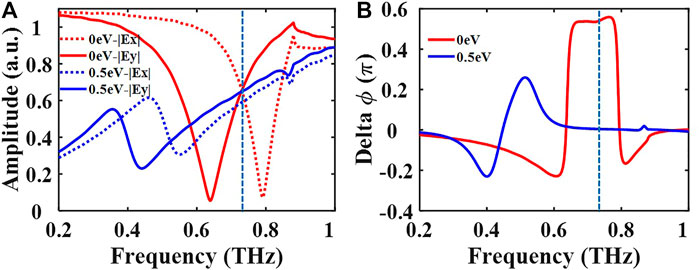
FIGURE 2. (A) Variations of the transmission amplitude components
In order to show the variation process of the transmitted THz polarization state along with the change of the graphene chemical potential, we calculated the difference between the transmission amplitude components,
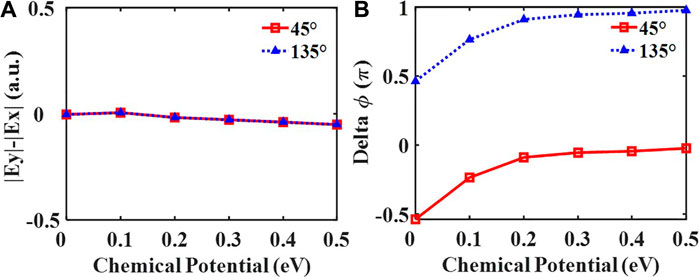
FIGURE 3. (A) The amplitude difference (
The polarization information of the transmitted wave can be represented by the Stokes parameters [
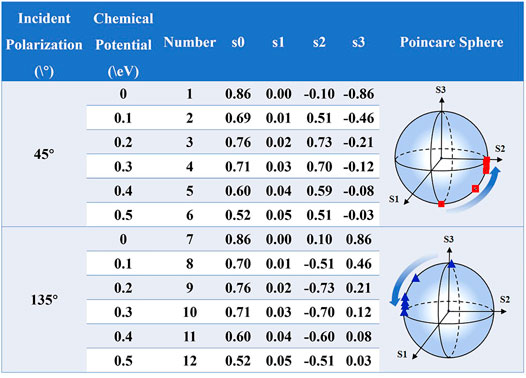
FIGURE 4. (Left column) The Stokes Parameters of the devices for the different graphene chemical potential with the THz incidence polarize angle 45°and 135°, respectively. (Right column) The Poincare Sphere is used to presents the polarization state of the device for different chemical potential of graphene.
To further understand the physics underlying inside of the proposed tunable metasurface, in Figures 5A,B, we stimulated the energy distribution on the gold cross for different graphene chemical potentials of 0 and 0.5 eV, respectively. As shown in Figure 5A, the THz energy is uniformly distributing on the two arms of the whole cross, respectively, the energy distribution on the arm along with the x-axis is stronger than that on the arm along with the y-axis, with energy intensity of 7 × 10–1 when chemical potential of graphene is 0 eV. However, the THz energy is mainly distributing the end of arms of the cross, when the chemical potential of graphene is increased to 0.5 eV, as shown in Figure 5B. Furthermore, the energy intensity is reduced to 5.7 × 10–2 which is much smaller than that energy intensity of 7 × 10–1. The above results indicating that interaction between the THz wave and the gold antenna will be gradually suppressed when the chemical potential of graphene is increasing, which results in reduction of the difference between phase components. Therefore, the polarization state of THz is actively controlled by the designed metasurface alone with the variation of the graphene chemical potential.
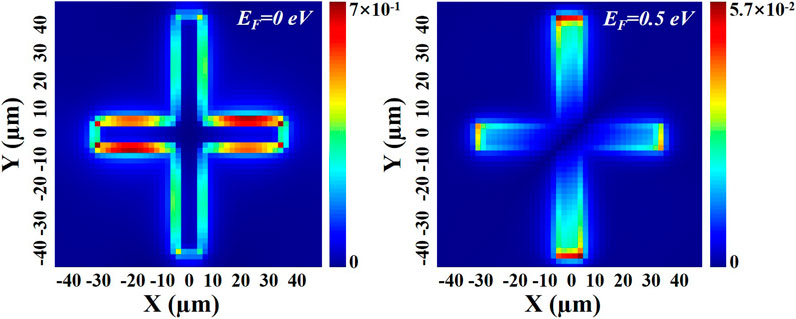
FIGURE 5. (A,B) The THz energy distribution on the gold cross for graphene chemical potentials of 0 and 0.5 eV, respectively.
Conclusion
In summary, we have demonstrated a tunable TQWP which is realized by integrating the monolayer graphene with a metallic metasurface. This composite device acts as a TQWP at the frequency of 0.73 THz before the chemical potential of graphene is changed, by which the polarization state of THz with incident polarize angle of 45° to x-axis is converted from linear polarization to circular polarization. When the chemical potential of the graphene is increased from 0 to 0.5 eV, the polarization state of the THz wave is converted from the right circular polarization to the right elliptical polarization, and to the linear polarization state of 45°. And we further achieved the polarization conversion from the left circular polarization state to the left elliptical polarization, and to the linear polarization state of 135° by rotating the devise clockwise, taking the z-axis as the center axis. A total polarization state conversion is achieved by our composite metasurface. We hope our work can further enriches the THz polarization devices, and provide a new route for designing the tunable polarization devices.
Data Availability Statement
The original contributions presented in the study are included in the article/Supplementary Material, further inquiries can be directed to the corresponding author.
Author Contributions
GW, BH and YZ concived the ideas, BH and YZ improved the ideas, GW conducted the design, mumerical simulations. GW prepared the manuscript. BH and MK supervised the project. All the authors discussed and analyzed the results.
Funding
National Natural Science Foundation of China (62050410347, 61875010).
Conflict of Interest
The authors declare that the research was conducted in the absence of any commercial or financial relationships that could be construed as a potential conflict of interest.
Publisher’s Note
All claims expressed in this article are solely those of the authors and do not necessarily represent those of their affiliated organizations, or those of the publisher, the editors and the reviewers. Any product that may be evaluated in this article, or claim that may be made by its manufacturer, is not guaranteed or endorsed by the publisher.
References
1. Khorasaninejad M, Capasso F. Metalenses: Versatile Multifunctional Photonic Components. Science (2017) 358(6367):eaam8100. doi:10.1126/science.aam8100
2. Li Z, Palacios E, Butun S, Aydin K. Visible-Frequency Metasurfaces for Broadband Anomalous Reflection and High-Efficiency Spectrum Splitting. Nano Lett (2015) 15(3):1615–21. doi:10.1021/nl5041572
3. Li Y, Zhang J, Zhang Y, Chen H, Fan Y. Wideband, Co-polarization Anomalous Reflection Metasurface Based on Low-Q Resonators. Appl Phys A (2016) 122(9):851. doi:10.1007/s00339-016-0374-3
4. Pfeiffer C, Grbic A. Controlling Vector Bessel Beams with Metasurfaces[J]. Phys Rev Appl (2014) 2(4):044012. doi:10.1103/physrevapplied.2.044012
5. He J, Wang X, Hu D, Ye J, Feng S, Kan Q, et al. Generation and Evolution of the Terahertz Vortex Beam. Opt Express (2013) 21(17):20230–9. doi:10.1364/oe.21.020230
6. Guo J-Y, Wang X-K, He J-W, Zhao H, Feng S-F, Han P, et al. Generation of Radial Polarized Lorentz Beam with Single Layer Metasurface. Adv Opt Mater (2018) 6(1):1700925. doi:10.1002/adom.201700925
7. Jiang X-Y, Ye J-S, He J-W, Wang X-K, Hu D, Feng S-F, et al. An Ultrathin Terahertz Lens with Axial Long Focal Depth Based on Metasurfaces. Opt Express (2013) 21(24):30030–8. doi:10.1364/oe.21.030030
8. Wang B, Wu X, Zhang Y. Multiple-Wavelength Focusing and Demultiplexing Plasmonic Lens Based on Asymmetric Nanoslit Arrays. Plasmonics (2013) 8(4):1535–41. doi:10.1007/s11468-013-9569-z
9. Ho JS, Qiu B, Tanabe Y, Yeh AJ, Fan S, Poon ASY. Planar Immersion Lens with Metasurfaces. Phys Rev B (2015) 91(12):125145. doi:10.1103/physrevb.91.125145
10. Roberts A, Lin L. Plasmonic Quarter-Wave Plate. Opt Lett (2012) 37(11):1820–2. doi:10.1364/ol.37.001820
11. Pors A, Nielsen MG, Bozhevolnyi SI. Broadband Plasmonic Half-Wave Plates in Reflection. Opt Lett (2013) 38(4):513–5. doi:10.1364/ol.38.000513
12. Zhao Y, Alù A. Tailoring the Dispersion of Plasmonic Nanorods to Realize Broadband Optical Meta-Waveplates. Nano Lett (2013) 13(3):1086–91. doi:10.1021/nl304392b
13. Jiang ZH, Lin L, Ma D, Yun S, Werner DH, Liu Z, et al. Broadband and Wide Field-Of-View Plasmonic Metasurface-Enabled Waveplates. Sci Rep (2014) 4:7511. doi:10.1038/srep07511
14. Wang D, Gu Y, Gong Y, Qiu C-W, Hong M. An Ultrathin Terahertz Quarter-Wave Plate Using Planar Babinet-Inverted Metasurface. Opt Express (2015) 23(9):11114–22. doi:10.1364/oe.23.011114
15. Li Z, Liu W, Cheng H, Chen S, Tian J. Realizing Broadband and Invertible Linear-To-Circular Polarization Converter with Ultrathin Single-Layer Metasurface. Sci Rep (2015) 5:18106. doi:10.1038/srep18106
16. Jiang Y, Wang L, Wang J, Akwuruoha CN, Cao W. Ultra-Wideband High-Efficiency Reflective Linear-To-Circular Polarization Converter Based on Metasurface at Terahertz Frequencies. Opt Express (2017) 25(22):27616–23. doi:10.1364/oe.25.027616
17. Pors A, Nielsen MG, Valle GD, Willatzen M, Albrektsen O, Bozhevolnyi SI. Plasmonic Metamaterial Wave Retarders in Reflection by Orthogonally Oriented Detuned Electrical Dipoles. Opt Lett (2011) 36(9):1626–8. doi:10.1364/ol.36.001626
18. Sarma R, Campione S, Goldflam M, Shank J, Noh J, Le LT, et al. A Metasurface Optical Modulator Using Voltage-Controlled Population of Quantum Well States. Appl Phys Lett (2018) 113(20):201101. doi:10.1063/1.5055013
19. Zhang Y, Zhao Y, Liang S, Zhang B, Wang L, Zhou T, et al. Large Phase Modulation of THz Wave via an Enhanced Resonant Active HEMT Metasurface. J Nanophotonics (2018) 8(1):153–70. doi:10.1515/nanoph-2018-0116
20. He J, Xie Z, Sun W, Wang X, Ji Y, Wang S, et al. Terahertz Tunable Metasurface Lens Based on Vanadium Dioxide Phase Transition. Plasmonics (2016) 11(5):1285–90. doi:10.1007/s11468-015-0173-2
21. Liu X, Wang Q, Zhang X, Li H, Xu Q, Xu Y, et al. Thermally Dependent Dynamic Meta‐Holography Using a Vanadium Dioxide Integrated Metasurface. Adv Opt Mater (2019) 7(12):1900175. doi:10.1002/adom.201900175
22. Fang Z, Wang Y, Schlather AE, Liu Z, Ajayan PM, de Abajo FJ, et al. Active Tunable Absorption Enhancement with Graphene Nanodisk Arrays. Nano Lett (2014) 14(1):299–304. doi:10.1021/nl404042h
23. Dai S, Ma Q, Liu MK, Andersen T, Fei Z, Goldflam MD, et al. Graphene on Hexagonal boron Nitride as a Tunable Hyperbolic Metamaterial. Nat Nanotech (2015) 10:682–6. doi:10.1038/nnano.2015.131
24. Guo J, Wang T, Zhao H, Wang X, Feng S, Han P, et al. Reconfigurable Terahertz Metasurface Pure Phase Holograms. Adv Opt Mater (2019) 7(10):1801696. doi:10.1002/adom.201801696
25. Wang T, He J, Guo J, Wang X, Feng S, Kuhl F, et al. Thermally Switchable Terahertz Wavefront Metasurface Modulators Based on the Insulator-To-Metal Transition of Vanadium Dioxide. Opt Express (2019) 27(15):20347. doi:10.1364/oe.27.020347
26. Huang Y-W, Lee HWH, Sokhoyan R, Pala RA, Thyagarajan K, Han S, et al. Gate-Tunable Conducting Oxide Metasurfaces. Nano Lett (2016) 16(9):5319–25. doi:10.1021/acs.nanolett.6b00555
27. Wang D, Zhang L, Gu Y, Mehmood MQ, Gong Y, Srivastava A, et al. Switchable Ultrathin Quarter-Wave Plate in Terahertz Using Active Phase-Change Metasurface. Sci Rep (2015) 5:15020. doi:10.1038/srep15020
28. Zhao X, Schalch J, Zhang J, Seren HR, Duan G, Averitt RD, et al. Electromechanically Tunable Metasurface Transmission Waveplate at Terahertz Frequencies. Optica (2018) 5(3):303–10. doi:10.1364/optica.5.000303
29. Luo X, Hu F, Li G. Dynamically Reversible and strong Circular Dichroism Based on Babinet-Invertible Chiral Metasurfaces. Opt Lett (2021) 46(6):1309–12. doi:10.1364/ol.421016
30. Liu W, Hu B, Huang Z, Guan H, Li H, Wang X, et al. Graphene-enabled Electrically Controlled Terahertz Meta-Lens. Photon Res (2018) 6(7):703–8. doi:10.1364/prj.6.000703
31. Huang J, Guan H, Hu B, Wang G, Liu W, Wang Z, et al. Enhanced Terahertz Focusing for a Graphene-Enabled Active Metalens. Opt Express (2020) 28(23):35179–91. doi:10.1364/oe.409746
Keywords: THz, polarization, tunable, graphene, metasurface
Citation: Wang G, Hu B, Khan MI and Zhang Y (2021) Active Control of the THz Wave Polarization State by an Electronically Controlled Graphene Composite Metasurface. Front. Phys. 9:751026. doi: 10.3389/fphy.2021.751026
Received: 31 July 2021; Accepted: 24 August 2021;
Published: 06 September 2021.
Edited by:
Meng Chen, Tsinghua University, ChinaCopyright © 2021 Wang, Hu, Khan and Zhang. This is an open-access article distributed under the terms of the Creative Commons Attribution License (CC BY). The use, distribution or reproduction in other forums is permitted, provided the original author(s) and the copyright owner(s) are credited and that the original publication in this journal is cited, in accordance with accepted academic practice. No use, distribution or reproduction is permitted which does not comply with these terms.
*Correspondence: Bin Hu, aHViaW5AYml0LmVkdS5jbg==
 Guocui Wang
Guocui Wang Bin Hu
Bin Hu Muhammad Ismail Khan1
Muhammad Ismail Khan1 Yan Zhang
Yan Zhang